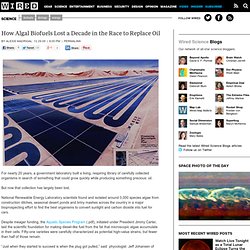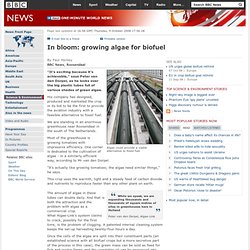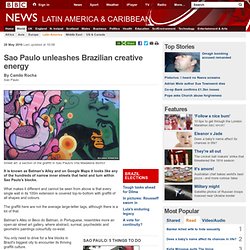

Africa_do_Sul. Litio. Algal Biofuels - Diesel - History. For nearly 20 years, a government laboratory built a living, respiring library of carefully collected organisms in search of something that could grow quickly while producing something precious: oil.

But now that collection has largely been lost. National Renewable Energy Laboratory scientists found and isolated around 3,000 species algae from construction ditches, seasonal desert ponds and briny mashes across the country in a major bioprospecting effort to find the best organisms to convert sunlight and carbon dioxide into fuel for cars. Despite meager funding, the Aquatic Species Program (.pdf), initiated under President Jimmy Carter, laid the scientific foundation for making diesel-like fuel from the fat that microscopic algae accumulate in their cells.
Fifty-one varieties were carefully characterized as potential high-value strains, but fewer than half of those remain. In bloom: growing algae for biofuel. "It's exciting because it's achievable," says Peter van den Dorpel, as he looks over the big plastic tubes full of various shades of green algae.

His company has designed, produced and marketed the crop in its bid to be the first to provide the aviation industry with a feasible alternative to fossil fuel. We are standing in an enormous greenhouse near Roosendaal in the south of The Netherlands. Most of the greenhouse is growing tomatoes with impressive efficiency. One corner is dedicated to the cultivation of algae - in a similarly efficient way, according to Mr van den Dorpel. "It's actually like growing tomatoes; the algae need similar things," he says. This crop uses the warmth, light and a steady feed of carbon dioxide and nutrients to reproduce faster than any other plant on earth.
The amount of algae in these tubes can double daily. What Algae-Link's system claims to crack, possibly for the first time, is the problem of clogging. But that may not be out of the question. CO2 eater. Hard graft: sugarcane for biofuel. It is four o'clock in the morning and Cicero Montiro de Silva is up and getting ready for the field.

He is a sugarcane cutter and it is harvest time. He leaves home as dawn breaks. Climbing on board a bus packed with other cutters, he heads out into a landscape covered in ripe sugarcane. Across Brazil at this time of year hundreds of thousands of cutters are making the same journey, sharing the long, hard days of the harvest. "I'm used to it now," he says, "but it's exhausting.
The work of the harvest has not changed much since the Portuguese introduced sugarcane to Brazil 500 years ago - it involves machetes and hard labour. The difference is that the cane hacked from these fields is part of an energy revolution. The sugarcane cut in these fields will be distilled into ethanol and then used to power cars and lorries across Brazil, or be shipped around the world. With an industry that began in the 1970s, biofuel has made Brazil an agricultural superpower.
There is independent approval. Sao Paulo unleashes Brazilian creative energy. 28 May 2010Last updated at 10:09 By Camilo Rocha Sao Paulo Street art: a section of the graffiti in Sao Paulo's Vila Madalena district It is known as Batman's Alley and on Google Maps it looks like any of the hundreds of narrow inner streets that twist and turn within Sao Paulo's blocks.

What makes it different and cannot be seen from above is that every single wall in its 100m extension is covered top-to-bottom with graffiti of all shapes and colours. The graffiti here are not the average large-letter tags, although there is a lot of that. Batman's Alley or Beco do Batman, in Portuguese, resembles more an open-air street art gallery, where abstract, surreal, psychedelic and geometric paintings colourfully co-exist. Continue reading the main story You only need to drive for a few blocks in Brazil's biggest city to encounter its thriving graffiti culture. It is the most visible expression of a new, creative, buzzing Sao Paulo that has emerged in the last 10 years.
Clear Nuclear Energy. Photo: Thomas Hannich The thick hardbound volume was sitting on a shelf in a colleague’s office when Kirk Sorensen spotted it.

A rookie NASA engineer at the Marshall Space Flight Center, Sorensen was researching nuclear-powered propulsion, and the book’s title — Fluid Fuel Reactors — jumped out at him. He picked it up and thumbed through it. Hours later, he was still reading, enchanted by the ideas but struggling with the arcane writing. “I took it home that night, but I didn’t understand all the nuclear terminology,” Sorensen says.
Published in 1958 under the auspices of the Atomic Energy Commission as part of its Atoms for Peace program, Fluid Fuel Reactors is a book only an engineer could love: a dense, 978-page account of research conducted at Oak Ridge National Lab, most of it under former director Alvin Weinberg. At the time, in 2000, Sorensen was just 25, engaged to be married and thrilled to be employed at his first serious job as a real aerospace engineer.